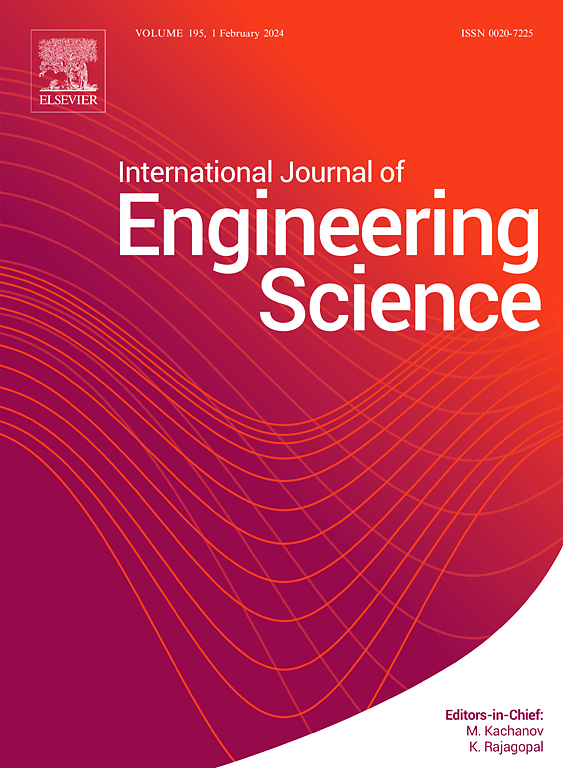流变连接的概念扩展到使用多种自然构型的有限变形框架
IF 5.7
1区 工程技术
Q1 ENGINEERING, MULTIDISCIPLINARY
International Journal of Engineering Science
Pub Date : 2025-04-12
DOI:10.1016/j.ijengsci.2025.104267
引用次数: 0
摘要
材料的本构行为通常是用一个由不同流变元素组成的网络来模拟的。这些流变模型大多是在一维小应变框架内建立的。将这些模型扩展到三维有限变形设置的关键障碍之一是确定如何将不同类型的连接(即串联连接和并行连接)纳入材料模型。本文的主要目标是制定一个适当的策略来解决这个问题。我们表明,两个流变元件之间的串联和并联连接都可以在多个自然构型框架内建模,而无需改变或引入新的构型。串联和并联连接的差异表现在相关流变元件变形期间所消耗的应力功率的比率上。一些著名的流变模型的有限变形版本已经被用来证明所提出的理论的实用性。本文章由计算机程序翻译,如有差异,请以英文原文为准。
On the extension of the concept of rheological connections to a finite deformation framework using multiple natural configurations
The constitutive behaviors of materials are often modeled using a network of different rheological elements. These rheological models are mostly developed within a one-dimensional small strain framework. One of the key impediments of extending these models to a three-dimensional finite deformation setting is to determine how the different types of connections, i.e., a series and a parallel connection, are incorporated into the material models. The primary objective of this article is to develop an appropriate strategy to address this issue. We show that both the series and the parallel connection between two rheological elements can be modeled within a multiple natural configurations framework without changing or introducing new configurations. The difference in a series and a parallel connection is manifested in the ratio of the stress powers expended during the deformations of the associated rheological elements. Finite deformation version of some well-known rheological models have been used to demonstrate the utility of the proposed theory.
求助全文
通过发布文献求助,成功后即可免费获取论文全文。
去求助
来源期刊

International Journal of Engineering Science
工程技术-工程:综合
CiteScore
11.80
自引率
16.70%
发文量
86
审稿时长
45 days
期刊介绍:
The International Journal of Engineering Science is not limited to a specific aspect of science and engineering but is instead devoted to a wide range of subfields in the engineering sciences. While it encourages a broad spectrum of contribution in the engineering sciences, its core interest lies in issues concerning material modeling and response. Articles of interdisciplinary nature are particularly welcome.
The primary goal of the new editors is to maintain high quality of publications. There will be a commitment to expediting the time taken for the publication of the papers. The articles that are sent for reviews will have names of the authors deleted with a view towards enhancing the objectivity and fairness of the review process.
Articles that are devoted to the purely mathematical aspects without a discussion of the physical implications of the results or the consideration of specific examples are discouraged. Articles concerning material science should not be limited merely to a description and recording of observations but should contain theoretical or quantitative discussion of the results.
 求助内容:
求助内容: 应助结果提醒方式:
应助结果提醒方式:


